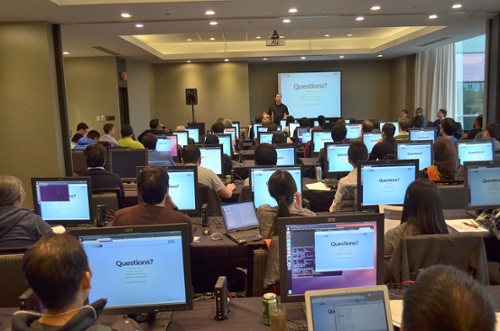
Corporate training programs can often end up being a disappointment: that’s just the plain hard truth most business managers find hard to swallow.
According to the American Society for Training and Development (ATD), most North American firms spend an average of $1200 a year training an employee, for a combined national spend of more than $300 billion dollars.
With a skills retention rate of less than 20% for new training, that’s a colossal monetary loss. So why is it so and what can be done about it? Here are the top reasons why corporate training fails to deliver and how to avoid this.
However, there are some ways to avoid the abyss of corporate training.
Get help with your online course development >>
Lack of Training-Needs Analysis
Companies have a habit of being hasty when it comes to jumping onto new training before actually doing a comprehensive training-needs analysis; this process understandably has to be much more extravagant than filling a needs-based survey by the employee on his own.
For companies, training-needs analysis should be the crucial first stage in the training process and must involve a well thought out formula to determine whether training will indeed address the problem, which itself should have been identified.
Only when such matters have been recognized and discussed that the skills, concepts and attitudes of the human elements of a system can be effectively identified and appropriate training can be specified.
Reaction vs Learning
Companies mistake their employees’ reaction to the training they get with actual learning. Rest assured, positive or negative employee reactions to new training has no correlation with the actual learning process itself.
It is crucial that companies make this differentiation and not see training as a tool for employee retention or boosting morale but use it as an actual learning mechanism. For e.g., one way to monitor learning is to actually track progress through a quality LMS which provides comprehensive tracking and observational tools.
Technology as a Panacea
Unfortunately, it is assumed that implementing a technological solution such as an LMS will solve all training problems. Yes of course, a technological solution such as an LMS will make it ten times easier to generate and impart training but it will not be able to solve all the company’s training problems in itself.
To impart effective training, the company also needs rich and specific learning goals, right administrative support, an internal form of measurement or assessment, the environment to practice the skills learnt and consistent openings to get feedback.
Poor Training Designs
Poor Design is the holy grail of poor corporate training. Unless there is a systematic way of analyzing training mechanisms, corporate training will fail. Most companies send their employees to workshops, seminars and events assuming that there would be a pre-built design built into the training which will just magically train their employees.
This is certainly not so and apart from a good few hours of laughs and free lunches, the result is that different employees end up experiencing training according to their own motivations and skills, with no common dividers and no quantifiable metric for the company to analyze. It is unrealistic to send an unskilled employee to a workshop and expect a “trained” employee at the end.
A quality solution to all this is perhaps provided by a quality LMS, as it will have expertly designed course solutions, lectures and instructional design elements along with a consistent user experience pre-built for retaining the “art of learning”.
Poor Testing Mechanisms
Skills decay is a constant nuisance companies face every day. Research studies show that 80-90% of all training imparted just fades away as employees forget or fail to implement their learning till the time the skills themselves become obsolete.
A major factor in all this is the type of testing that happens after training sessions. In an absence of a self paced learning solution such as an LMS, training effectively ends up becoming a cram session with a no-good memorization based exam at the end. It is folly to believe that anything good would come out of such an arrangement, and it never does.
It is crucial that a technological solution such as an LMS be implemented that signals to the employees that learning and not testing is important in this organization. It’s about constructing in employees the psychological model that if I absorb this learning, if I know more, it is to my advantage. I will be more sought-after.
As an LMS is a scalable solution, this should then be echoed through the organization till the time learning and not merely training becomes part of the corporate DNA.
Contact Us and Get Help With Training
Here at Udutu, we take great pride in helping our corporate clients avoid these mistakes and implement cost effective, undisruptive and engagement based learning solutions that actually make a difference. Contact us to help us help you make this transition.[/vc_column_text][/vc_column][/vc_row]







